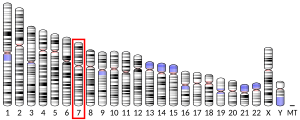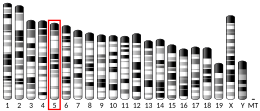SMURF1
E3 ubiquitin-protein ligase SMURF1 is an enzyme that in humans is encoded by the SMURF1 gene.[5][6] The SMURF1 Gene encodes a protein with a size of 757 amino acids and the molecular mass of this protein is 86114 Da.[7]
Function
[edit]Smad ubiquitination regulatory factor 1 (Smurf1) is part of a gene that encodes a ubiquitin ligase and is specific for receptor-regulated SMAD proteins in the bone morphogenetic protein (BMP) pathway.
A similar protein in Xenopus is involved in embryonic pattern formation. Alternative splicing results in multiple transcript variants encoding different isoforms. An additional transcript variant has been identified, but its full length sequence has not been determined.[6]
HIV
[edit]The inhibition of HIV-1 replication in HeLa P4/R5 cells can be achieved by siRNA-mediated knockdown of SMURF1.[8]
Cancer
[edit]Breast
[edit]SMURF1 and SMURF2 have shown to exhibit E3 ligase-dependent and E3 ligase-independent activities in a multitude of different cell types whereby smurfs can act as tumor promoters or tumor suppressors by regulating biological tumorigenesis-related processes. Recent research in breast cancer explains a relationship between SMURF1 and ER alpha (Estrogen receptor alpha) during breast cancer growth. Since ER alpha is expressed in most breast cancers and is attributed to contributing to the progression of estrogen-dependent cancer, it has been supported that the reduction of SMURF1 decreases the proliferation of ER alpha-positive cells in vitro and in vivo.[9] Thus, it is feasible that targeting SMURF1 may become a potential therapy for ER alpha-positive breast cancer.
Gastrointestinal
[edit]Smurf1 may the potential to act as an oncogenic factor in other essential organs of the body. For instance, high levels of SMURF1’s are linked to low survival rates of patients who are diagnosed with gastric cancer (GC) and clear cell renal cell carcinoma (ccRCC). Similarly to the suppression of SMURF1 to possibly treat breast cancer, the inhibition of Smurf1 can decrease tumorigenesis in various types of digestive cancer cell models like pancreatic and gastric cancers.[10]
Neurodegenerative Disorders
[edit]Continued research shows that SMURF1 can also been linked to various diseases. The downregulation of SMURF1 expression has been observed in neurodegenerative disorders such as Alzheimer's disease and Parkinson's disease. Research is showing that SMURF1 plays a role in neuronal necroptosis whereby the up-regulation of Smurf1 was observed in the brain cortex of adult rats who experienced neuroinflammation, and Smurf1 knockdown with siRNA inhibited neuronal necroptosis.[11] This suggests that Smurf1 may promote neuronal necroptosis in neuroinflammatory conditions.
SMURF1 expression was increased in brain tissue samples from Parkinson's disease patients compared to controls, and that this increase was positively correlated with the accumulation of α-synuclein aggregates. Furthermore, the overexpression of SMURF1 in cultured cells led to increased levels of α-synuclein aggregates, while knockdown of SMURF1 reduced α-synuclein aggregation.[12] In the context of neurodegeneration, SMURF1 has been implicated in the regulation of protein quality control mechanisms such as autophagy and the ubiquitin-proteasome system, which are critical for the clearance of misfolded or aggregated proteins that can contribute to disease pathogenesis.
While the exact mechanisms by which SMURF1 contributes to neurodegenerative disorders are still not fully understood, there is growing evidence, research studies may suggest that SMURF1 may be a potential target for therapeutic intervention in protein aggregation and improving cellular proteostasis in neurodegenerative diseases.[13]
Post Translational Modifications
[edit]Under the influence of NDFIP1, it undergoes auto-ubiquitination. The SMURF1 protein is modified by the SCF(FBXL15) complex at two lysine residues, Lys-381 and Lys-383, which leads to its degradation by the proteasome. Whereby, Lys-383 is the primary site of ubiquitination.[14]
Interactions
[edit]Smurfs are composed of several distinct domains that include an N-terminal C2 domain, two to three WW domains containing tryptophan residues, and an HECT domain. The C2 domain plays a crucial role in mediating the interaction of Smurfs with intracellular membranes. On the other hand, the WW domains of Smurfs are typically involved in protein-protein interactions, allowing them to interact with various target proteins.[15] SMURF1 has been shown to interact with:
- ARHGEF9[16]
- PLEKHO1[17]
- SMURF2[18]
- TRAF4[19]
- Interacts with FBXL15 (via HECT domain)[19]
- SMAD7[19]
- TGFBR1[19]
References
[edit]- ^ a b c ENSG00000198742 GRCh38: Ensembl release 89: ENSG00000284126, ENSG00000198742 – Ensembl, May 2017
- ^ a b c GRCm38: Ensembl release 89: ENSMUSG00000038780 – Ensembl, May 2017
- ^ "Human PubMed Reference:". National Center for Biotechnology Information, U.S. National Library of Medicine.
- ^ "Mouse PubMed Reference:". National Center for Biotechnology Information, U.S. National Library of Medicine.
- ^ Zhu H, Kavsak P, Abdollah S, Wrana JL, Thomsen GH (August 1999). "A SMAD ubiquitin ligase targets the BMP pathway and affects embryonic pattern formation". Nature. 400 (6745): 687–693. Bibcode:1999Natur.400..687Z. doi:10.1038/23293. PMID 10458166. S2CID 204995261.
- ^ a b "Entrez Gene: SMURF1 SMAD specific E3 ubiquitin protein ligase 1".
- ^ "SMURF1 Gene - GeneCards | SMUF1 Protein | SMUF1 Antibody". www.genecards.org. Retrieved 2023-04-26.
- ^ Zhou H, Xu M, Huang Q, Gates AT, Zhang XD, Castle JC, et al. (November 2008). "Genome-scale RNAi screen for host factors required for HIV replication". Cell Host & Microbe. 4 (5): 495–504. doi:10.1016/j.chom.2008.10.004. PMID 18976975.
- ^ Yang H, Yu N, Xu J, Ding X, Deng W, Wu G, et al. (February 2018). "SMURF1 facilitates estrogen receptor ɑ signaling in breast cancer cells". Journal of Experimental & Clinical Cancer Research. 37 (1): 24. doi:10.1186/s13046-018-0672-z. PMC 5808446. PMID 29433542.
- ^ Fu L, Cui CP, Zhang X, Zhang L (December 2020). "The functions and regulation of Smurfs in cancers". Seminars in Cancer Biology. 67 (Pt 2): 102–116. doi:10.1016/j.semcancer.2019.12.023. PMID 31899247. S2CID 209672264.
- ^ Shao L, Liu X, Zhu S, Liu C, Gao Y, Xu X (May 2018). "The Role of Smurf1 in Neuronal Necroptosis after Lipopolysaccharide-Induced Neuroinflammation". Cellular and Molecular Neurobiology. 38 (4): 809–816. doi:10.1007/s10571-017-0553-6. PMID 28940129. S2CID 254384236.
- ^ Chen X, Hou X, Luo X, Zhou S, Liu X, Liu B, Chen J (2019). "Altered Intra- and Inter-regional Functional Connectivity of the Anterior Cingulate Gyrus in Patients With Tremor-Dominant Parkinson's Disease Complicated With Sleep Disorder". Frontiers in Aging Neuroscience. 11: 319. doi:10.3389/fnagi.2019.00319. PMC 6881235. PMID 31824298.
- ^ Han D, Li S, Xia Q, Meng X, Dong L (January 2022). "Overexpressed Smurf1 is degraded in glioblastoma cells through autophagy in a p62-dependent manner". FEBS Open Bio. 12 (1): 118–129. doi:10.1002/2211-5463.13310. PMC 8727935. PMID 34614303.
- ^ Wang Y, Tong X, Ye X (December 2012). "Ndfip1 negatively regulates RIG-I-dependent immune signaling by enhancing E3 ligase Smurf1-mediated MAVS degradation". Journal of Immunology. 189 (11): 5304–5313. doi:10.4049/jimmunol.1201445. PMID 23087404. S2CID 34478186.
- ^ Koganti P, Levy-Cohen G, Blank M (2018). "Smurfs in Protein Homeostasis, Signaling, and Cancer". Frontiers in Oncology. 8: 295. doi:10.3389/fonc.2018.00295. PMC 6082930. PMID 30116722.
- ^ Yamaguchi K, Ohara O, Ando A, Nagase T (April 2008). "Smurf1 directly targets hPEM-2, a GEF for Cdc42, via a novel combination of protein interaction modules in the ubiquitin-proteasome pathway". Biological Chemistry. 389 (4): 405–413. doi:10.1515/BC.2008.036. PMID 18208356. S2CID 27505034.
- ^ Lu K, Yin X, Weng T, Xi S, Li L, Xing G, et al. (August 2008). "Targeting WW domains linker of HECT-type ubiquitin ligase Smurf1 for activation by CKIP-1". Nature Cell Biology. 10 (8): 994–1002. doi:10.1038/ncb1760. PMID 18641638. S2CID 19216909.
- ^ Fukunaga E, Inoue Y, Komiya S, Horiguchi K, Goto K, Saitoh M, et al. (December 2008). "Smurf2 induces ubiquitin-dependent degradation of Smurf1 to prevent migration of breast cancer cells". The Journal of Biological Chemistry. 283 (51): 35660–35667. doi:10.1074/jbc.M710496200. PMID 18927080.
- ^ a b c d "UniProt". www.uniprot.org. Retrieved 2023-04-23.
Further reading
[edit]- Wrana JL, Attisano L (2000). "The Smad pathway". Cytokine & Growth Factor Reviews. 11 (1–2): 5–13. doi:10.1016/S1359-6101(99)00024-6. PMID 10708948.
- Andersson B, Wentland MA, Ricafrente JY, Liu W, Gibbs RA (April 1996). "A "double adaptor" method for improved shotgun library construction". Analytical Biochemistry. 236 (1): 107–113. doi:10.1006/abio.1996.0138. PMID 8619474.
- Yu W, Andersson B, Worley KC, Muzny DM, Ding Y, Liu W, et al. (April 1997). "Large-scale concatenation cDNA sequencing". Genome Research. 7 (4): 353–358. doi:10.1101/gr.7.4.353. PMC 139146. PMID 9110174.
- Nagase T, Kikuno R, Nakayama M, Hirosawa M, Ohara O (August 2000). "Prediction of the coding sequences of unidentified human genes. XVIII. The complete sequences of 100 new cDNA clones from brain which code for large proteins in vitro". DNA Research. 7 (4): 273–281. doi:10.1093/dnares/7.4.271. PMID 10997877.
- Ebisawa T, Fukuchi M, Murakami G, Chiba T, Tanaka K, Imamura T, Miyazono K (April 2001). "Smurf1 interacts with transforming growth factor-beta type I receptor through Smad7 and induces receptor degradation". The Journal of Biological Chemistry. 276 (16): 12477–12480. doi:10.1074/jbc.C100008200. PMID 11278251.
- Suzuki C, Murakami G, Fukuchi M, Shimanuki T, Shikauchi Y, Imamura T, Miyazono K (October 2002). "Smurf1 regulates the inhibitory activity of Smad7 by targeting Smad7 to the plasma membrane". The Journal of Biological Chemistry. 277 (42): 39919–39925. doi:10.1074/jbc.M201901200. PMID 12151385.
- Tajima Y, Goto K, Yoshida M, Shinomiya K, Sekimoto T, Yoneda Y, et al. (March 2003). "Chromosomal region maintenance 1 (CRM1)-dependent nuclear export of Smad ubiquitin regulatory factor 1 (Smurf1) is essential for negative regulation of transforming growth factor-beta signaling by Smad7". The Journal of Biological Chemistry. 278 (12): 10716–10721. doi:10.1074/jbc.M212663200. PMID 12519765.
- Koinuma D, Shinozaki M, Komuro A, Goto K, Saitoh M, Hanyu A, et al. (December 2003). "Arkadia amplifies TGF-beta superfamily signalling through degradation of Smad7". The EMBO Journal. 22 (24): 6458–6470. doi:10.1093/emboj/cdg632. PMC 291827. PMID 14657019.
- Wang HR, Zhang Y, Ozdamar B, Ogunjimi AA, Alexandrova E, Thomsen GH, Wrana JL (December 2003). "Regulation of cell polarity and protrusion formation by targeting RhoA for degradation". Science. 302 (5651): 1775–1779. Bibcode:2003Sci...302.1775W. doi:10.1126/science.1090772. PMID 14657501. S2CID 21530222.
- Asano Y, Ihn H, Yamane K, Kubo M, Tamaki K (January 2004). "Impaired Smad7-Smurf-mediated negative regulation of TGF-beta signaling in scleroderma fibroblasts". The Journal of Clinical Investigation. 113 (2): 253–264. doi:10.1172/JCI16269. PMC 310747. PMID 14722617.
- Jin YH, Jeon EJ, Li QL, Lee YH, Choi JK, Kim WJ, et al. (July 2004). "Transforming growth factor-beta stimulates p300-dependent RUNX3 acetylation, which inhibits ubiquitination-mediated degradation". The Journal of Biological Chemistry. 279 (28): 29409–29417. doi:10.1074/jbc.M313120200. PMID 15138260.
- Shearwin-Whyatt LM, Brown DL, Wylie FG, Stow JL, Kumar S (July 2004). "N4WBP5A (Ndfip2), a Nedd4-interacting protein, localizes to multivesicular bodies and the Golgi, and has a potential role in protein trafficking". Journal of Cell Science. 117 (Pt 16): 3679–3689. doi:10.1242/jcs.01212. hdl:2440/9578. PMID 15252135.
- Bryan B, Cai Y, Wrighton K, Wu G, Feng XH, Liu M (February 2005). "Ubiquitination of RhoA by Smurf1 promotes neurite outgrowth". FEBS Letters. 579 (5): 1015–1019. doi:10.1016/j.febslet.2004.12.074. PMID 15710384. S2CID 36440933.
- Barrios-Rodiles M, Brown KR, Ozdamar B, Bose R, Liu Z, Donovan RS, et al. (March 2005). "High-throughput mapping of a dynamic signaling network in mammalian cells". Science. 307 (5715): 1621–1625. Bibcode:2005Sci...307.1621B. doi:10.1126/science.1105776. PMID 15761153. S2CID 39457788.



